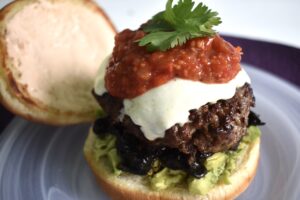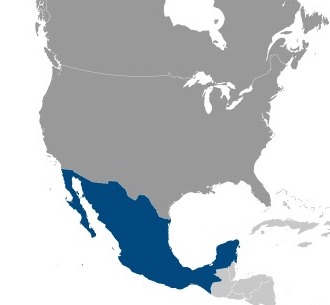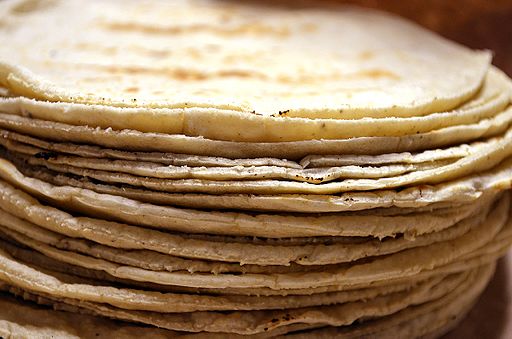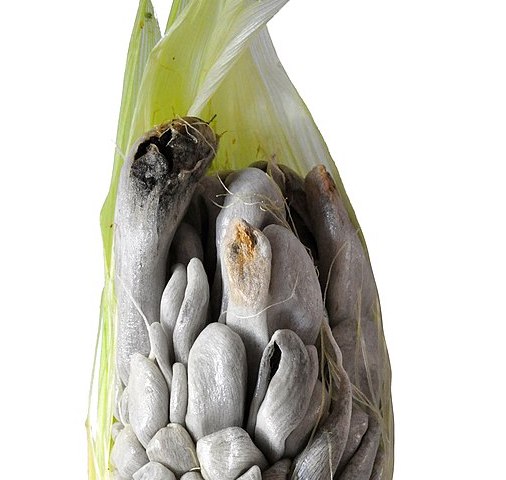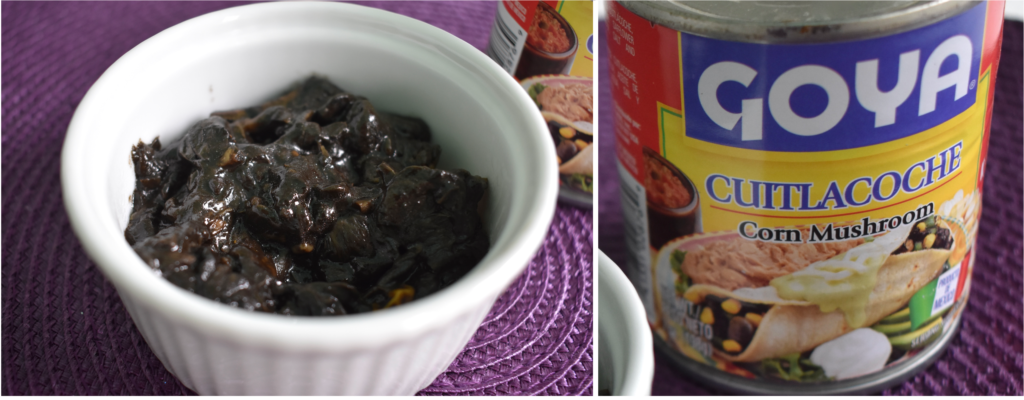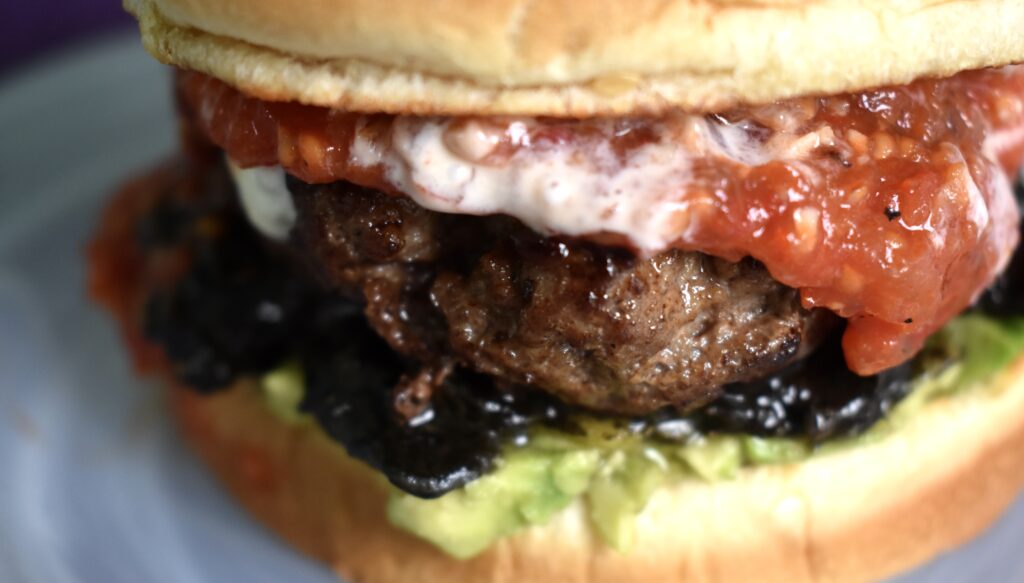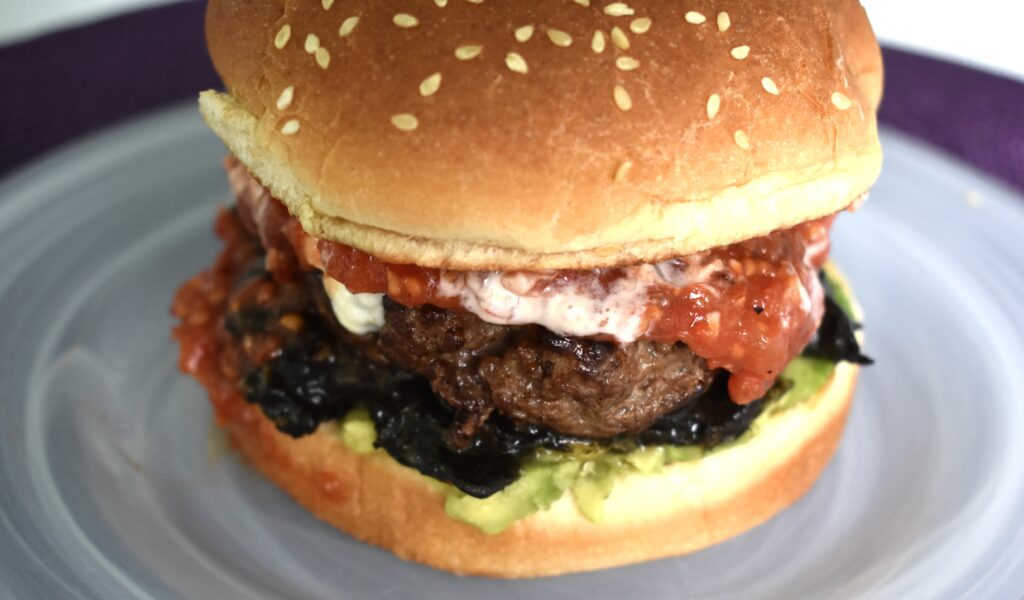
Burger with Roasted Tomato Salsa, Avocado, Mexican Crema, and Huitlacoche
Full disclosure, I’m a huge fan of Mexican food. I love it all, from the uber authentic food you can get in some neighborhoods in large cities in America, to the home-made menudo that an ex-boyfriend’s mom made for us, and even including all of the pseudo Mexican food we have in the US – yes, “Yo quiero Taco Bell!” So I was very excited to find our next stop on this alphabetical journey around the world is Mexico.
The history of Mexican food is the history of the people who have lived and ruled over this beautiful country. Let’s start around 10,000 BC – archeologists have found evidence of nomadic people inhabiting Mexico as far back as 10,000 BC. The Olmecs, circa 1500 BC, were the first complex civilization in Mexico. Evidence suggest that they enjoyed beans and corn as staples in their cuisine.
The rise of the Maya culture (circa 250 AD), brought larger cities and cultivated fields. Corn was the major crop along with beans, tomatoes and chilis. Most of the sources I found credit the Maya with the creation of the tortilla. Tortillas are still a huge part of Mexican food and the stereotypical Americanized version of Mexican food is basically a celebration of the tortilla in many forms.
The Aztecs brought a greater focus on chilis, particularly chipotle (smoke jalapeño), salt, and chocolate (note: chocolate use dates back to Olmecs). Then the Spanish came in and added sheep, cows, pigs, wheat, and dairy. Cheese, glorious cheese! Despite the desire of the Spanish to have their food dominate over indigenous flavors, the Mexican people just added the ingredients brought by the Spanish to their already rich culinary traditions. And always, at the core, corn, chilis, and beans.
In addition to the core, Mexico is also blessed with and abundance of indigenous and imported produce that are featured heavily the cuisine. Tomatoes are used in most dishes and avocados are loved across the country. Mexico produces almost 30% of the world’s avocados. Squash and Vanilla are also important staples. Traditional Mexican cuisine has such a rich history and complexity that it is included on the UNESCO Intangible Cultural Heritage list (it was the only full cuisine I could find on the list).
With so much to choose from, how to make a burger that can live up to that kind of cultural gravitas? If we could represent France and Italy, we can do justice to Mexican cuisine (I hope). And don’t worry, we’re leaving Taco Bell at the mall.
Americans tend to think the only authentic dish in Mexican cuisine is molé. There are as many recipes for molé as there are families in Mexico, most include chocolate as the signature ingredient in this smokey savory sauce. The sauce also includes chilies and a variety of spices. Mexican chocolate is dark and bitter and compliments the spicy smokey chilis. Most of the molé recipes I’ve seen have over a dozen ingredients, and most chefs will tell you that the sauce needs time to develop the complexity of flavor it deserves. I’ve tried to make a molé before and I think it’s better left to the professionals and the people who have been making it for years. It certainly isn’t worth the effort unless it’s going to be the absolute star of the dish.
We are fortunate enough to have a really good authentic Mexican restaurant not too far from us, and one dish I’ve had there was really memorable because it had an ingredient I have never tasted before and that tastes like nothing I’ve ever tasted.
Huitlacoche (weet·luh·kow·chay), also known as Cuitlacoche, Corn Smut, or Corn Truffle (if you want to sound fancy) is this amazing ingredient that is earthy, sweet, and absolutely unique. The problem is, it’s ugly, really ugly, and when you find out what it is, that doesn’t increase the appeal. Huilacoche is an invasive fungus that grows on corn cobs before the cobs are ripe. How anyone thought, “gee, that grey gook looks yummy”, I have no clue. Fresh Huilacoche is very difficult to find, but canned or jarred is easier to find. I ordered it online because it wasn’t in my local grocery store. When it’s canned, it gets very dark – and ends up looking like black slime with chunks of corn. Are you sold yet?
I promise, it is worth the effort to find a can and try this out. It is also delicious with fish – the restaurant I first had it at served it with a panned seared halibut and fresh lime – it was divine.
Once I settled on huitaloche as the unique flavor, I knew I needed to layer in classic flavors. Since huitaloche does have a corn flavor, corn was covered. Avocado was a must, of course. Some kind of salsa seemed natural to add – I chose a chiltomate salsa which is a traditional Yucatan roasted vegetable salsa. The smokiness added just the right element to balance the other flavors.
For the patty, I decided to stick with beef – since our last two were chicken and fish, beef seemed like a nice change of pace. Thank you to the Spanish for bringing cows to Mexico!
I took some inspiration from a traditional sandwich, Cemita Poblano. The cemita bun sounds close to the American sesame seed bun that we love for our burgers, so thankfully I didn’t have wrap a burger in a tortilla (I really didn’t want to do that). The cemita poblano also uses queso oaxaca – this is a white cheese similar to mozzarella but with a little more salt and flavor. It pulls apart like mozzarella. When I made this burger for my family, I pulled it apart before melting it on the burger – that kind of made a mess of my pan, so for the final version, I sliced it – this resulted in a thicker coating of melted cheese – either way it’s yummy.
The resulting burger was easily one of my favorite dishes so far, also one of the messiest. These flavors blended together perfectly. A touch of spice, a hint of smoke, lovely acid, rich fattiness, and earthy sweetness. No one flavor dominated, instead they combined and made the whole greater than the sum of its parts. I’ve eaten a lot of burgers over the course of this project, and this is the best balance I’ve achieved. It just tasted GOOD! I suggest serving with several napkins for each guest – and stick with paper napkins, no need to get corn smut or salsa on grandma’s linens.
This is a great burger to have with beer, I’d go with an amber ale if I could drink it. Since I can’t (allergic), I paired it with a Shiraz (on the lighter side vs a big bold one).
If you like this burger, you might enjoy my Columbian Burger. It’s equally messy and filled with surprising and wonderful flavors.
©Copyright 2023 Linda Monach
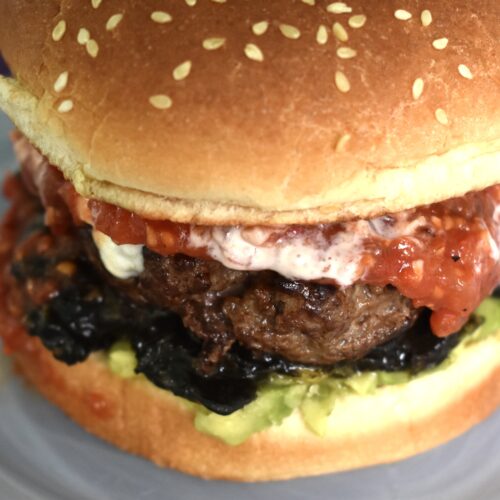
Mexican Burger
Ingredients
Chiltomate – Roasted Tomato Salsa
- 1 Medium Yellow Onion
- 4 Cloves of Garlic (smashed)
- 2 Hot Peppers (halved and seeded) The pepper you choose will drive the spiciness of this dish
- 36 Cherry Tomatoes
- Kosher Salt (to taste)
Chipotle Crema
- 1/2 cup Crema Mexicana
- 3/4 Tbsp Chipotle Adobo Sauce For more spice, you can add the chipotle peppers and add to taste
- Kosher Salt (to taste)
Mexican Burger
- Olive Oil
- 4 Sesame Seed Buns
- 1 Ripe Avocado (mashed roughly)
- Fresh Lime Juice
- 7 oz Huitlacoche
- 1 lb Ground Beef (80% lean)
- Salt & Pepper
- 6 oz Oaxaca Cheese (sliced thin)
- Chopped Fresh Cilantro (optional)
Instructions
Chiltomate – Roasted Tomato Salsa
- Cut the onion into wedges approx 1/2" thick. Place all ingredients on a foil lined baking sheet. Broil for 5-10 minutes then turn over and broil for another 5 minutes until everything is lightly charred. Keep an eye on this as broiler temps vary and you don't want to burn the veggies.
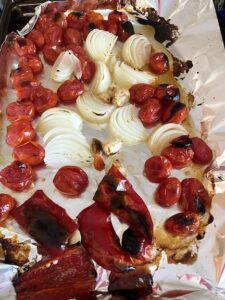
- Once the vegetables are charred and soft, put them in a food processor and pulse until smooth. Salt to taste.Salsa can be made ahead and refrigerated. It's best on the burger if you warm it to room temperature.
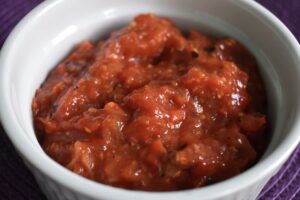
Chipotle Crema
- Mix the crema and adobo sauce and add salt to taste. Add chopped chipotle peppers if you want more heat. Cover and refrigerate until ready to use.
Mexican Burger
- Brush a non-stick pan with olive oil and heat until shimmering. Add the buns to the pan, cut side down, and cook until lightly browned. Set aside until you're ready to assemble the burgers.
- Slice avocado in half and remove pit. NOTE: never try to dig the pit out with the point of your knife, just use knife to lightly chop into pit, twist and remove.
- Slice the avocado then scoop with a spoon. Smash the avocado roughly and sprinkle with fresh lime juice.
- Heat the huitlacoche in a small pan until just warmed through.
- Form four balls from the ground beef. Flatten the balls and generously salt and pepper each patty. Heat 1-2T olive oil in the non-stick skillet. Cook the burger patties to desired doneness. Just before burgers are cooked through, add cheese slices and cover to melt the cheese. (If the cheese isn't melting, add a small amount of water to pan and cover to speed melting).
- To assemble the burgers. Spread crema on each top bun. Spoon avocado onto each bottom bun, then add huitlacoche.
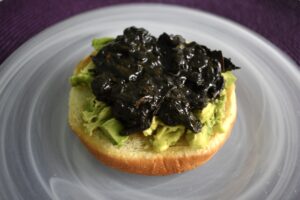
- Place burger patties on top of huitlachoche. Now add a scoop of chiltomate (salsa) and some chopped cilantro (optional). Top with top bun and serve with lots of napkins. We also put the extra salsa on the table so those who wanted could add more (and we did!).
